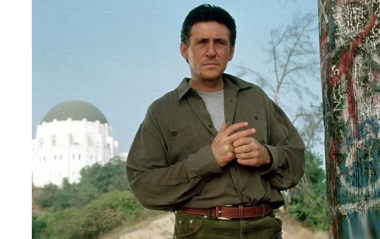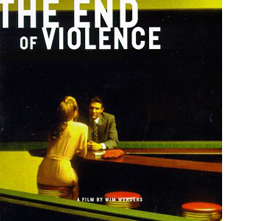
 |
|
|
|
"Define violence." German filmmaker Wim Wenders sits on a pretty high roost hereabouts, not only for his marvelous international hits Wings of Desire and Paris, Texas, but for his amazing, underrated science fiction epic Until the End of the World. The 1991 picture blends Wenders' road-movie instincts with a transcendent sci-fi concept; his vision of 1999 didn't predict the Internet but he nails our millennial dependence on/addiction to personal electronics. 
When I heard that Wenders was finishing a lavish science fiction film for MGM called The End of Violence, I couldn't wait to see it. The movie has its fans, and there will always be a reason to give the creative Wenders the benefit of the doubt, should he make a film that seems to miss the mark. I was initially disappointed by his Lisbon Story but now applaud its laid-back idyll amid Portuguese streets with the music of Madredeus. Unfortunately The End of Violence refuses to come into focus for this reviewer and fan. Wenders and his writer Nicholas Klein delve into a pile of Southern California paranoid fantasies and expecs magic to occur. Almost every aspect of the picture is a letdown -- the story, the ideas behind the various parts of the story, his visual approach and even much of the direction of the actors. A big hit is the music of Ry Cooder, but it also seems an alien entity imposed upon a vision of Los Angeles imagined by a foreign celebrity who only knows what he sees from the Malibu Beach or the Hollywood Hills. Critics once clobbered Italian director Michelangelo Antonioni for making a film in California, about The Revolution. Remember the phrase? "How You Get There Depends on Where You're At?" After seeing The End of Violence, Antonioni's Zabriskie Point suddenly seems packed with sage insights.
Wenders' show has an ultra-polished studio look, not his older road-picture primitive style or the wonderful globetrotting glamour-travelogue appeal of his Until the End of the World. The story is difficult to synopsize. Slick producer Mike Max (Bill Pullman) makes violent blockbusters. He runs his little movie empire from home via his laptop computer, with his assistant Claire (Rosalind Chao) sending him constant updates. He doesn't pay much attention when Claire mentions an odd E-mail message he's received. His bored trophy wife Paige (Andie MacDowell) lives like a queen in their ocean cliff-top house, but is so alienated that she
Detective 'Doc' Dean Brock (Loren Dean) investigates the freeway murders and falls in love with Cat, who is still working on Mike's movie "The Seeds of Violence", directed by the oppressively harsh Zoltan Kovacs (Udo Kier). It's her big opportunity, but Paig's lawyers move in on to shut the film down. Mike eventually sneaks back to see Paige, only for her to aim a gun at him. 
Wait, wait, you ain't seen nothing yet. Mike's problem is sourced in the E-mail that he never read. The conspiracy is trying to finalize an orbiting surveillance network that can track anybody on Earth at any time, to enforce law and order and "put an end to violence". Working for them is technician Ray Bering (Gabriel Byrne) who is currently test-running a new Los Angeles system that monitors the city from thousands of conventional cameras installed everywhere. Bering's headquarters-lab is in the Griffith Park Observatory, which appears to have been closed to the public; Ray builds the system by day and then goes home to take care of his elderly father Louis (director Sam Fuller). Ray acquires a conscience through a relationship with his maid Mathilda (Marisol Padilla Sánchez), a Salvadoran refugee whose back is covered with torture scars. Ray was the one who sent Mike Max the fateful E-mail message. Although few details are explained, the story threads finally converge when Detective "Doc" contacts Ray Bering, and they agree to a secret meeting.
The End of Violence wants to be profound but falls way short of the mark. Its paranoia film clichés went out with The Conversation and The Parallax View, twenty years before. It's as if Wenders were in unfamiliar territory and unaware that he's reinventing a genre with parts discarded from bad movies. The sinister security types wear dark glasses and drive dark vans, and are just a bore. The idea of the city wide surveillance system is a bore - inadequately visualized and wholly impractical to boot. How much criminal activity could be detected that way, before the fact? The same goes for the satellite cameras, which exist but never lived up to the PR baloney about reading license plates from orbit. It's not that the movie must concentrate on hardware, but its proposed sinister surveillance systems don't begin to make sense. Wenders lifts the great video surveillance idea pioneered in Fritz Lang's mind-boggling The 1,000 Eyes of Dr. Mabuse but hasn't integrated it into his story. For a while we wonder if
Wenders and Klein float ten undeveloped ideas, simultaneously. He expends substantial screen time showing us things we already know about the class divide -- there are folks on top like Mike Max, and service-oriented people like Rapper Six O One that make a living by kissing up to them. People like Kat are just trying to make a go of it creatively. Further down the dunghill are a multitude of dispossessed nobodies. Mike Max's instant demotion from top dog to invisible nobody at first has possibilities; Luis Buñuel floated more than one wicked farce on that premise. But despite its scenes in East L.A. the movie has no real feeling for the underclass. The family meal at gardener Henry Silva's picnic table expresses little. Then there's the film's insufferable performance art digressions, where various fashionable fringe spokespeople recite poetry and force-feed us pretentious messages. Six O One has second thoughts about his violent music? How unlikely is that? Most everyone stares at the camera at one point or another to define violence, or say something else about it. Hideous clunker dialogue abounds: "You know that certain atomic particles change when they're observed?" After decades of fresh, intriguing pictures like The American Friend, Wenders retreats to sub-Tarantino posing. People point guns at each other's noses, and then continue with 'meaningful' dialogue. Paige holds Mike at bay with a chrome automatic, but he talks her into stripping just to give him a goodbye thrill. The even more Tarantino-ish scene under the freeway is excruciatingly amateurish, as if the poor actors playing the kidnappers had been told to start at top pitch and improvise from there. Maybe Wenders really wanted to return to a location from Paris, Texas. 
Equally awful are the perfume-commercial visuals at the beach house. Andie McDowell pouts as if she hasn't been told what the movie is about, or who she is supposed to be. Evil lizard-for-rent Udo Kier looks like he wandered in from a Lars Von Trier movie. His noxious film director creeps out Kat with instructions to 'Fuck Him' that may or may not be motivational acting direction for the scene. Just as bad are the scenes on a movie set made to look like the Hopper painting Nighthawks. Could no one advise Wenders as to how uncreative it was to mimic that visual? Did he want to emulate the kitschy posters that place Marilyn Monroe and James Dean in Hopper's diner? Both Wings of Desire and Until the End of the World have deeply emotional, resonant scenes where lovers reunite in atmospheric old saloons, at the bar. Is the Nighthawks travesty trying to continue that tradition? Some of the acting in Violence is just fine, but the talents of Traci Lind, Pruitt Taylor Vince, Marshall Bell, Frederic Forrest, Loren Dean, Henry Silva and many of the smaller parts seem either misdirected or not directed at all. The meandering script sets up interesting ideas that never begin to take shape. Torture victim Mathilda moves Ray to an activist position? That must be what happens, but we don't feel it. Cynical Mike Max becomes a decent dude after a few days living with the East L.A. Latinos? It's like every event in this film rolls snake eyes, right down to the 'meaningful' confrontation on the Santa Monica Pier (wow, what a novel location) and the picturesque helicopter shot finale. 
Although the cinematography is attractive, we don't get any particular feel for Los Angeles. The freeway overpass is made to look beautiful, which is a real stretch. We still feel as if we're in low-budget movie land, where the script reads 'vast technological conspiracy' but what we see are maybe twenty TV monitors set up in an anteroom in the Griffith Observatory, where a lone scientist eats fast food and chews on his pencil. The End of Violence disappointed because in 1997 it looked as if MGM's one-year burst of quality filmmaking -- Goldeneye, The Birdcage, Rob Roy, Get Shorty -- was over. The second Brosnan Bond was a terrible pastiche. I'd just seen the three-part long version of Wenders' superb Until the End of the World, a sci-fi picture with a wonderfully rich futuristic world, now 15 years in the past, already! I think I would be relieved to be told that The End of Violence was Wenders' Godard-like expression of Contempt, a purposeful 'drop dead' message to MGM. It's very disheartening to accept it at face value. Olive Films' Blu-ray of The End of Violence is a beautiful encoding of this very handsome widescreen (Super-35?) show, with many a pretty image courtesy of cinematographer Pascal Rabaud. Ry Cooder is the name most prominent on the moody soundtrack, which I play often at home. This is a good-looking and mellow-sounding feature film. The one extra is the film's trailer. I feel really motivated to want to like this show, but after re-watching it several times the magic light bulb has yet to light up. I know I'll try again. I openly invite someone to make a case that alters my feelings about it... but no allusions to Antonioni's Blow-Up, please. 
On a scale of Excellent, Good, Fair, and Poor,

Reviews on the Savant main site have additional credits information and are often updated and annotated with footnotes, reader input and graphics.
Review Staff | About DVD Talk | Newsletter Subscribe | Join DVD Talk Forum |
| ||||||||||||||||||